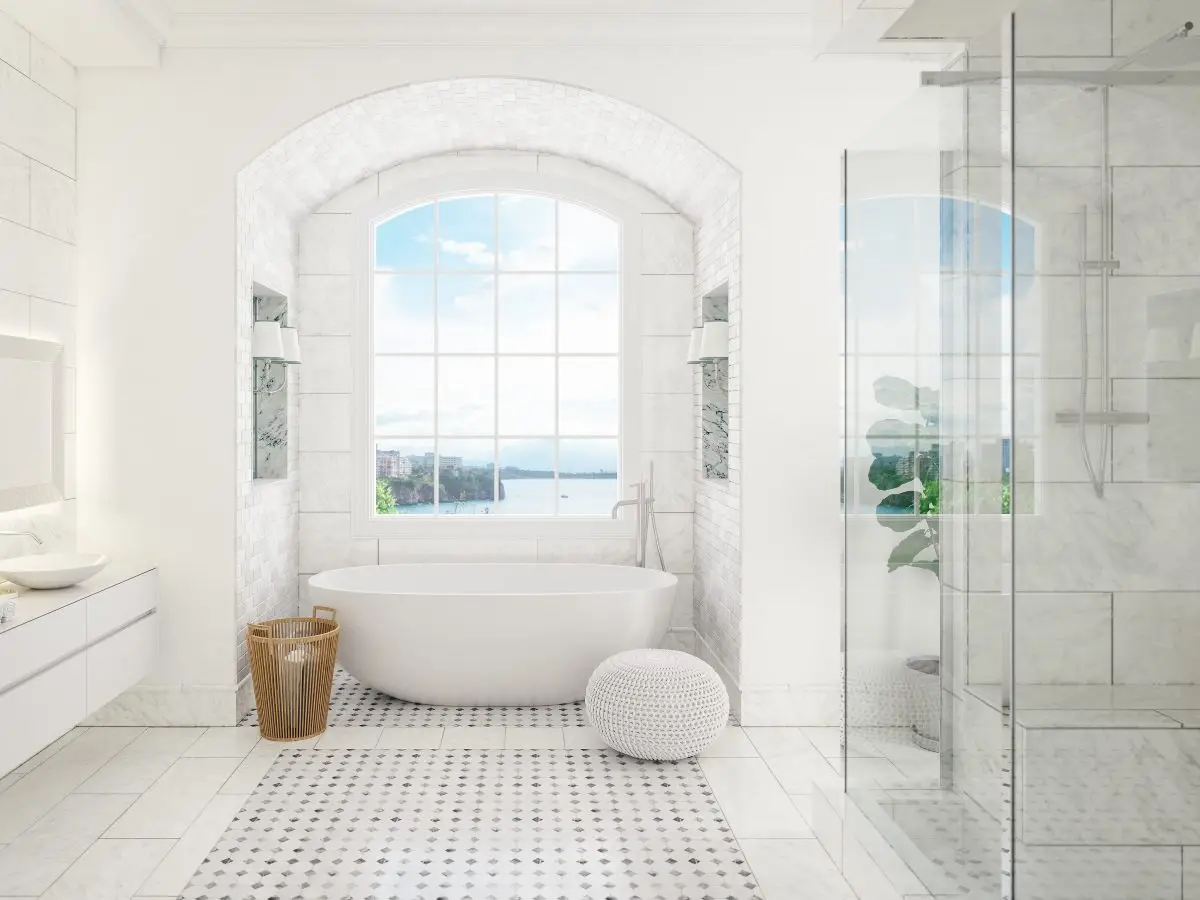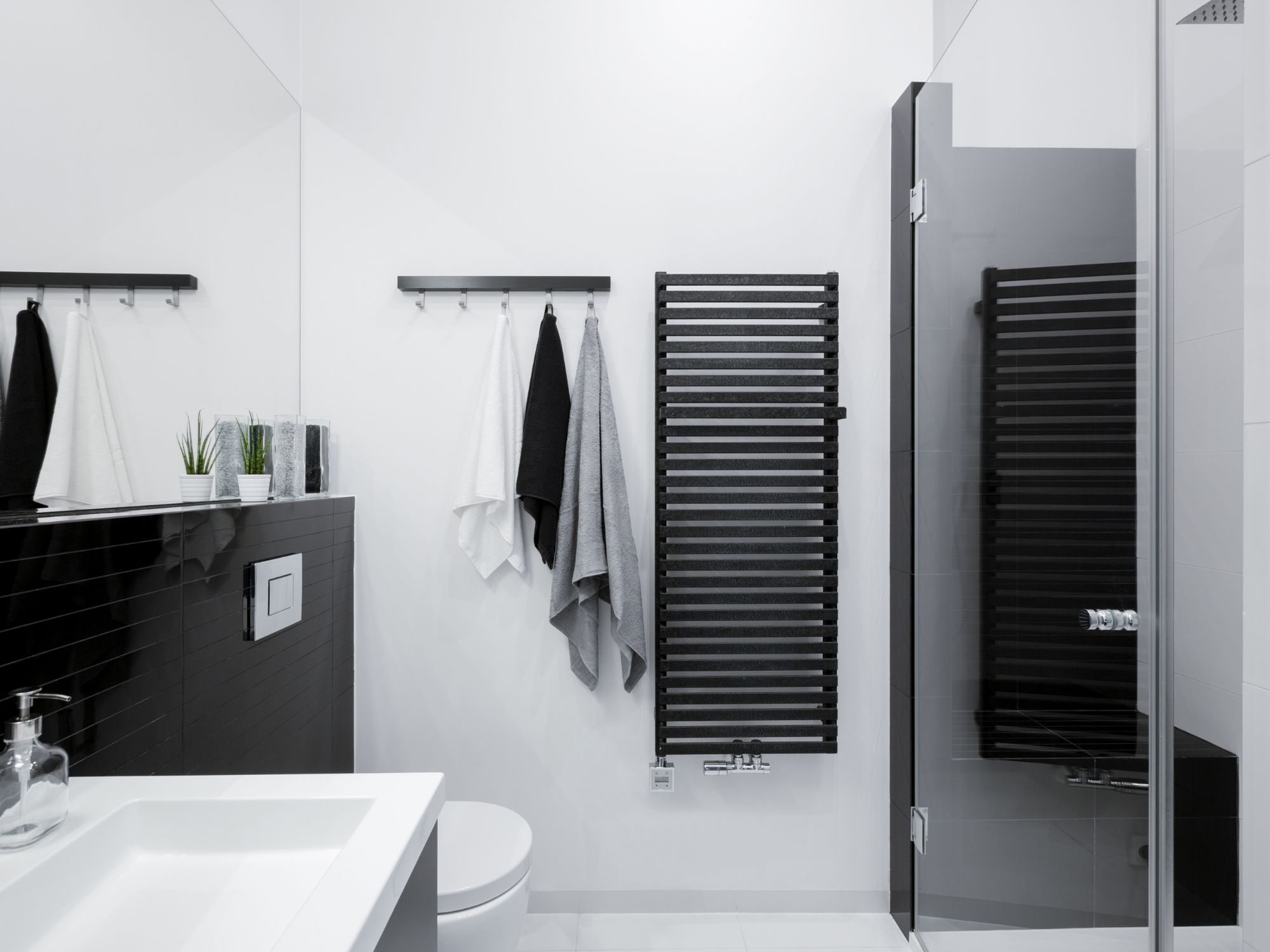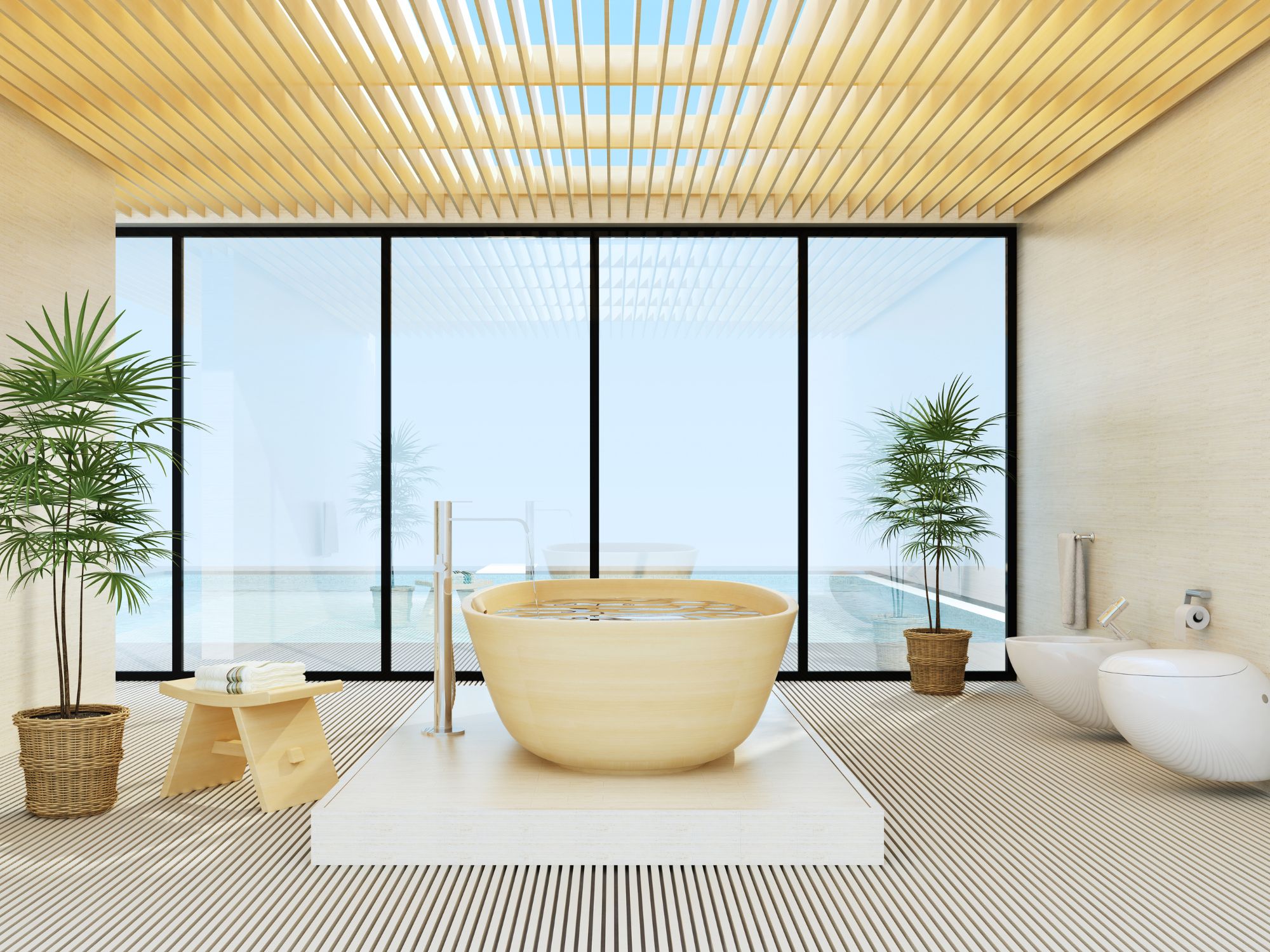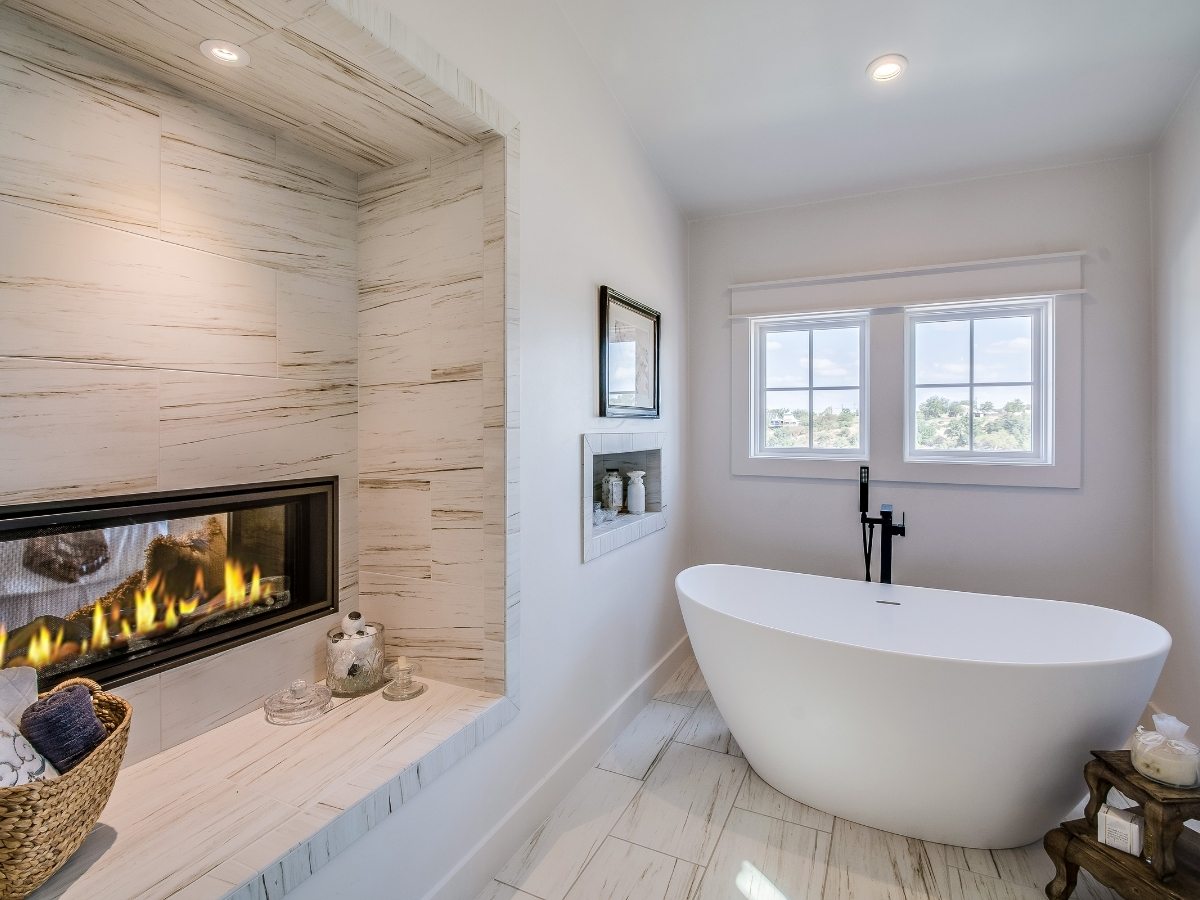This post may contain affiliate links which means I may receive a commission for purchases made through links at no cost to you. I only recommend products that I have personally used or curated specifically after reviewing and ensuring its quality! Learn more on my Private Policy page.
1. The Cost Imperative
Planning a bathroom remodel and wondering about the bathroom remodel cost? You’re not alone. Bathroom remodel costs can be a big concern for homeowners and investors. This article breaks down the financial elements you need to consider, ranging from materials and labor to project complexity, without overwhelming you with figures and unnecessary complications.
Let’s dive into the factors that will shape your remodeling expenses.
Purpose Of Article
This article, the first of a five part series arms homeowners and small investors with insights and guidance in making remodel decisions. The article focuses on compiling a Bathroom Remodel Cost and Budget for your remodel project.
In the second article we explored How Much Should You should Spend on a Bathroom Remodel and the third article explored strategies on how Bathroom Remodeling Enhances Investment Property Values.
The forth article provides insights and guidance in making remodel decisions relative to selecting Bathroom Remodel features that favors Enjoyment Value verses those that favor Return on Investment so as to foster decisions the promote financial recoverability.
In the fifth and final article we will review frequently asked questions and other key issues.
2. Key Takeaways
Bathroom remodel costs range from $70 to $300 per square foot with factors such as room size, material choices, labor expenses, and project complexity affecting the overall price. This cost range is for both professional and DIY approaches.
There are varying types of bathroom remodels, including cosmetic updates (average cost $1,500 to $5,000), mid-range cosmetic remodels ($5,000 to $15,000), and high-end cosmetic remodels with no layout changes ($15,000 to over $30,000), each offering different levels of renovation and finishes. These cost does not include major fixture installs, structural changes, layout changes, or electrical and plumbing work. These cost ranges are averages and median and above average remodel cost will be higher than suggested.
Altering the layout or structure of a bathroom, such as moving walls or changing the room’s layout, can add substantial costs, potentially ranging from $5,000 to $35,000 depending on scale or project complexity. This cost is in addition to the above ranges.
Cost-saving strategies for bathroom remodels include DIY efforts, smart material selection, and reusing elements, and avoiding structural and layout changes.
- Financing options may be available and include home equity loans, HELOCs, personal loans, and 0% APR credit cards.
3. Understanding Bathroom Remodel Costs
The costs to remodel a bathroom can vary significantly, often falling between $70 and $250 for each square foot. This range is influenced by several elements including:
The dimensions of the space
Selections made regarding materials
Costs associated with labor
The intricacy of the renovation
For an average small full bathroom measuring 40 square feet, you might expect to spend anywhere from $2,800 up to $10,000 on remodeling endeavors for minor remodels which consist of aesthetic, with no structural, layout or major fixture install. See below for cost breakdown details.
Now let’s delve into what specifically drives these varied expenses in bathroom remodel projects.

Room Size and Layout
Your bathroom’s dimensions and configuration are crucial determinants in the total expense of your bathroom remodel. Renovation costs increase with size, as larger bathrooms demand more materials and labor due to their greater square footage. For example, renovating a primary bathroom—which usually covers around 100 square feet—can incur an expenditure between $60,000 and $80,000.
Nevertheless, it’s important to recognize that regardless of the overall scale of the space being remodeled, hefty labor charges play a major role in ensuring that any bathroom refurbishment represents a notable outlay financially. This means even renovations involving small bathrooms can require a significant financial commitment.
Pro - Tip 1: Limiting the extend of layout changes to the physical space will reduce the remodel cost especially if structural, plumbing and electrical changes are not needed.

Material Choices
The materials you choose for your bathroom remodel can significantly affect the final cost. Here are some examples of countertop and flooring materials and their price range per square foot. These cost will depend on decor and aesthetic choices.
Ceramic countertop: $1 – $20
Marble countertop: $50 – $200
Ceramic flooring: $1 – $20
Radiant flooring: $30 – $65
Keep in mind that these prices are just estimates and can vary depending on factors such as location, product quality, and desired remodel outcome.
Custom-built vanities can be two to three times more expensive than prefabricated options, and the cost of installing unique tile patterns can range up to $16.50 per square foot. Therefore, prudent selection of materials is vital for managing the expenses of your bathroom remodel.

Some Key Fixtures and Material Components
High-quality materials such as marble, quartz, and custom cabinetry will increase costs
Tiles
The cost of tiles varies widely depending on the material, size, and design. Ceramic tiles are typically more affordable, ranging from $1 to $15 per square foot, while natural stone tiles can cost $15 to $50 per square foot. See our Resource Page for suppliers.
Fixtures
Prices for fixtures such as sinks, toilets, showers, and bathtubs vary depending on the brand, quality, and features. Basic fixtures can range from $100 to $500, while high-end options can exceed $1,000 or more.
Upgrading to premium fixtures and fittings can significantly impact the overall cost.
Faucets
Basic faucets can range from $50 to $250, while high-end options can exceed $500. Consider factors such as durability, style, and functionality when choosing faucets for your remodel.
Showerheads and Shower Systems
Prices for showerheads range from $20 to $500 for low range models or more depending on the brand, design, and features. Look for water-efficient models to save on utility costs over time. Shower systems and shower panels are much more costly depending on the intrusiveness of the installation and can range from $1,000 to $15,000 or more.
Cabinetry
Custom cabinetry tends to be more expensive, with prices ranging from $500 to $1,500 per linear foot. Stock or semi-custom cabinets are more budget-friendly, typically costing $100 to $500 per linear foot.
Countertops
The cost of countertops varies depending on the material, with options such as laminate averaging costing of $20 to $50 per square foot, and natural stone like granite or marble costing $50 to $200 per square foot.
Toilets and Bidets
Basic toilets typically cost $100 to $300, while high-efficiency or designer models can cost $500 to $1,500 or more. Consider factors such as water usage, flushing power, and aesthetics when selecting a toilet for your remodel.
Freestanding Bathtubs
Freestanding bathtubs come in a range of prices. Acrylic models typically start from $700 to $1,500, providing an affordable yet stylish option. Mid-range options, including higher-end acrylic and some resin tubs, can range from $1,500 to $3,000.
For premium materials like cast iron or copper, prices can range from $3,000 to over $5,000, reflecting their superior quality and durability.
These ranges provide in this article are approximate and can vary based on design complexity, brand, and additional features.
Spa Features
When considering a spa bathroom, homeowners should evaluate space, budget, and lifestyle needs. Factors like room for luxurious fixtures like steam generators, and fireplaces, cost of high-end materials, and desire for relaxation amenities play crucial roles in deciding whether to create a personal spa retreat at home. We explore these in our Blog Post article – Spa Bathroom Ideas.
Pro - Tip 2: Materials and fixture cost adds up really fast especially when the cost of installation is factored in, so be strategic with your choices.

Labor Expenses
Labor costs make up a substantial portion of bathroom remodel expenses, typically ranging from 40% to 65% of the overall project cost. Hence, these expenses must be factored in while setting a budget for your renovation. These costs can vary depending on geographical location and the complexity of the work involved. For instance, specialized tasks that require high expertise, like installing custom cabinetry or intricate tile work, may increase labor costs.
Furthermore, certain labor categories can have a significant impact on the overall budget. For example, the cost to hire a plumber for bathroom remodels can range from $45 to $200 per hour.
Pro - Tip 3: Given that the cost of labor is more than 50% of the cost of the remodel it is advisable to perform parts of the works as DIY should you happen to have DIY skills. If you do NOT have such skillsets then please hire a professional to achieve the desired outcome.
4. Project Complexity
The complexity of your bathroom remodel project can add significant costs. Some common factors that can increase the cost of a bathroom remodel include:
Altering the layout or structure of a bathroom, such as moving walls or changing the room’s layout, can add substantial costs, potentially ranging from $5,000 to $35,000 depending on scale or project complexity.
Plumbing adjustments are common in remodels and can vary widely in cost, such as $150 to $3,500 for repairs.
Electrical adjustments are also common and can range from $100 for new outlets to $2,000 for a complete rewiring. Again, depending on the scale of the work. Please get quote from contractor or electrician.
It’s important to consider these factors when planning your bathroom remodel to ensure you have a realistic budget in mind.
Complex remodels often require hiring professional services, such as structural engineers or general contractors, with costs ranging from $100 to $300 per hour depending where you are located. Hence our pro tip.
Pro - Tip 4: To rein in expenses in complex remodels, it is advisable to keep the load-bearing walls and the original layout intact and refrain from altering the bathroom’s plumbing or electrical circuits.
5. Types of Bathroom Remodels and Costs
The scale and cost of bathroom remodels can differ substantially, encompassing everything from simple cosmetic changes to extensive overhauls. They fall into three categories: minor cosmetic improvements, mid-tier remodeling projects, and upscale renovations, all differing in both price and extent.
Cosmetic Updates
Cosmetic bathroom updates, such as new faucets, a fresh coat of paint, or new light fixtures, are the most affordable remodel options, costing between $2,500 and $7,000 on average. The cost of painting a bathroom can range from $375 to $1,000. This can vary based on factors such as size, paint quality, and labor.
Other cosmetic updates can include:
Adding new light fixtures, which can cost an additional $200 to $1,000 or more depending on decor choices
Upgrading bathroom vanity hardware for a refreshed look, see above for cost details.
Painting or using acrylic panels instead of tiling for a fresh look at a lower cost
By maintaining plumbing and electrical configurations and focusing on cosmetic changes, you can save significant money while still achieving a refreshed look.

Mid-Range Bathroom Remodel Cost
Mid-range remodels, often including new tiling, fixtures, and plumbing adjustments within the current layout, typically range from $5,000 to $15,000 on average. These remodels offer a balance between cost and impact, allowing for substantial improvements without breaking the bank.
However, this cost will increase if changes to the layout is needed or removal and reinstall of major fixtures like toilets and tubs. As noted above, altering the layout, structure, major install in a bathroom can add substantial costs, potentially ranging from $5,000 to $35,000 and added to the above cost range.
For instance, fixture replacements during a mid-range remodel can include adding light fixtures at $300 to $1,500, exhaust fans around $200 to $800, upgraded doors from $500 to $2,000, and windows from $300 to over $1,200 for complex styles. Furthermore, new plumbing fixtures, such as faucets, have a cost range from $300 to $2,000 including installation, and toilets can range from $200 for low-flow models to over $3,000 for high-end smart toilets.

High-End Bathroom Remodeling Costs
High-end bathroom remodels are the most expensive, featuring top-of-the-line finishes, custom cabinetry, and significant layout alterations. These remodels start at $15,000 and can exceed $50,000. For example, custom cabinetry and built-ins can range from $3,000 to $15,000, reflecting the high costs associated with personalized design and luxury materials. Again, altering the layout, structure, major install in a bathroom can add substantial costs, potentially ranging from $5,000 to $35,000 and added to the above cost range.
High-end fixture upgrades such as walk-in showers or enclosures can range from $8,500 to over $20,000, highlighting the premium costs for customization. Moreover, some high-end remodels maintain the existing layout, while others require full gut renovations with wall, plumbing, and electrical changes, necessitating professional design and often increasing the project cost due to permitting and labor.
Pro - Tip 5: Make an informed decision related to the complexity of the desired bathroom remodel and the required budget based on the chosen remodel scenario.
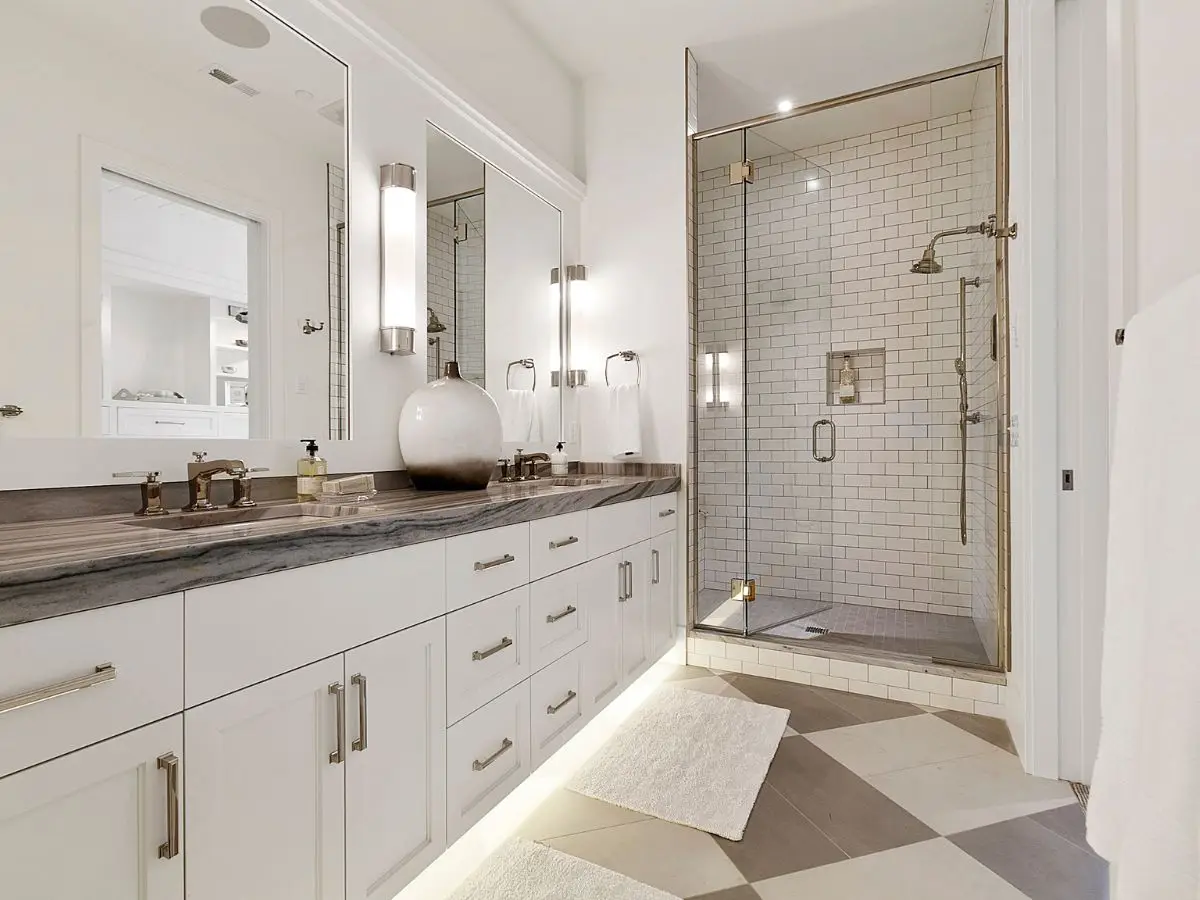
6. Saving Money on Your Bathroom Remodel
Bathroom renovations can often represent a substantial financial commitment, yet it is possible to economize while crafting an attractive and practical bathroom. Opting for a DIY bathroom remodel allows you to make savvy choices regarding materials and repurpose or recycle current fixtures.
On the other hand, should you lean towards having your makeover executed professionally or wish to convert your space into a wet room, meticulously evaluating and contrasting various contractors is critical in guaranteeing superior outcomes.
DIY Bathroom Remodel vs. Professional Help
Embarking on a DIY bathroom project can lead to significant savings on labor costs during your bath remodel. By opting to tackle the job personally, you might keep between $1,500 and $10,000 in your pocket that would have otherwise been spent paying professionals, depending on the scale of your project. Before diving into such an endeavor, it’s important to weigh both the benefits and drawbacks of taking on this type of project without professional assistance.
Despite the potential for saving money by managing your own bathroom remodeling work, one must be aware of the risks involved with going the DIY route. Mistakes like tiles not being sealed correctly or mishaps with plumbing and electrical installations could end up costing more down the line if they’re not done right initially.
When faced with complex renovations tasks within a bathroom upgrade process, you may find that investing in a professional contractor ultimately proves more economically prudent over time.
Smart Material Selection
Choosing cost-effective materials is a strategic way to diminish expenses during a bathroom remodel. Opting for less expensive alternatives like engineered wood, laminate flooring, or peel-and-stick tile over traditionally more expensive tiles can lessen the financial impact on your bathroom floor renovations.
Selecting look-alike materials that replicate the appearance of luxury finishes can trim down costs while maintaining an attractive visual quality in the bathroom space. Pre-assembled vanity units with integrated countertops are available between $3,000 and $20,000 depending on style and decor choices.
Reusing and Recycling
Significant savings can be achieved in a bathroom remodel by opting to recycle and refurbish the current elements of the space. For example, rather than buying new cabinets, refinishing what’s already there could drastically reduce expenses.
Conducting a thorough evaluation of existing bathroom fixtures to determine whether items such as toilets need replacing can decrease remodeling costs even further. Shopping at used home material stores might yield economical finds that seamlessly fit into your planned bathroom aesthetic.
Prioritizing Spending
Prioritize spending based on your individual needs and preferences. Focus on upgrades that will have the most significant impact on the overall look and functionality of your bathroom.
Allocate a larger portion of your budget to essential items such as fixtures, flooring, and plumbing, while leaving room for discretionary spending on decorative elements and accessories.
Be strategic about where you splurge and where you save. Invest in high-quality, durable materials for items that see heavy use, such as countertops and faucets, while opting for more budget-friendly options for less critical items.
Avoid Major Structural Changes
To reduce bathroom remodel cost it is advisable where possible to stick to the existing layout of your bathroom to avoid costly structural changes that can adversely impact the budget. Instead, focus on cosmetic and less costly functional updates that can make a big difference without requiring major renovations.
7. Planning Your Bathroom Remodeling Budget

Establishing a budget for your bathroom remodel is an essential part of the renovation process. Homeowners can use the average bathroom remodel costs, which stand at $11,533, as a foundational figure to plan their expenses.
Bathroom Renovation Costs – Setting Priorities
Establishing priorities is crucial to planning a budget effectively. Homeowners should define their renovation needs, making a clear distinction between indispensable must-haves and supplementary desirable features.
As an example, it’s recommended that homeowners give precedence to aspects that contribute to longevity and consistent functionality rather than choosing alternatives that might offer immediate financial relief yet potentially incur repeated replacements and subsequent expenses.
Prioritize upgrades based on your needs and budget constraints. Focus on essential improvements that provide the most value and impact.
Consider reusing existing materials or fixtures where possible to save on costs. Refinishing surfaces or repurposing furniture can give your bathroom a fresh new look without breaking the bank.
Shop smart for deals and discounts on materials and fixtures. Consider shopping at outlet stores, attending clearance sales, or purchasing gently used items to save money.
Pro - Tip 6: Be realistic about your expectations and avoid common misconceptions about remodeling costs. While it's possible to achieve a beautiful and functional bathroom on a budget, it's important to set realistic expectations based on your desired level of aesthetics, quality, and customization.

Permits And Fees
Depending on local building codes and regulations, you may need to obtain permits for your bathroom remodel. Permit fees can vary widely depending on the scope of the project and your location, ranging from $300 to $2,000 or more.
Contingency Planning
Another essential element of budgeting for a bathroom renovation is the inclusion of a contingency fund. Experts suggest reserving an additional 15-20% beyond the estimated total cost of remodeling to address unforeseen problems that may not become apparent until work begins, such as issues concealed beneath flooring or within walls—common in older properties.
Establishing a well-thought-out contingency reserve offers monetary adaptability during renovations. It empowers homeowners with the ability to redirect financial resources as needed or retain any unused funds, guaranteeing that even when unexpected costs arise, the project can proceed without interruption.
Pro - Tip 7: Be proactive in identifying potential risks and planning for them in your budget. Consult with your contractor to assess the likelihood of encountering unforeseen issues and adjust your contingency fund accordingly.
8. Budget Tools and Worksheet
Use budgeting tools or worksheets to help you estimate costs accurately and allocate funds effectively. Many online resources offer customizable budget templates specifically designed for home renovation projects.
Break down your budget into categories such as materials, fixtures, labor, permits, design services, and contingency funds. Allocate funds to each category based on your research and priorities for the remodel.
Please access our Bathroom Remodel Cost Worksheet to help plan your project. The data in the table is sample info for illustration only. Please used your local area prices to fill in the worksheet. Please reach out to us for assistance.
Common Bathroom Remodel Cost and Budget Challenges
One common budgeting challenge is underestimating costs or failing to account for all expenses. Be thorough in your research and planning to ensure you have a comprehensive understanding of the costs involved in your remodel.
Another challenge is overspending on unnecessary upgrades or indulging in impulse purchases. Stick to your budget and resist the temptation to exceed it, even if you encounter unexpected windfalls or incentives.
Pro - Tip 8: Communication is key to staying on track with your budget and schedule. Maintain open lines of communication with your contractor and other stakeholders throughout the remodeling process to ensure everyone is aligned on budgetary constraints and priorities. Ask Questions!
9. Summary Guide Table
Here is summary of some key remodel cost components and considerations to guide you through your decisions. The Cost noted in the table are averages and median and above average remodel cost can be significantly greater.
| Elements | Decision Considerations |
|---|---|
| Planning | Assess current layout, create a wish list, measure dimensions, research design trends and materials |
| Budgeting | Determine budget, research costs, allocate funds for materials, fixtures, labor, permits, use remodel cost worksheet, set aside contingency fund |
| Materials | Tiles, fixtures, cabinetry, countertops, flooring, paint, hardware, accessories |
| Fixtures | Sinks, toilets, spa bathroom considerations, showers, bathtubs, faucets, showerheads, mirrors, towel bars, toilet paper holders |
| Labor | Demolition, installation of fixtures and fittings, plumbing, electrical work, carpentry, painting, tiling, finishing touches |
| Permits and Fees | Obtain necessary permits, pay permit fees, comply with building codes and regulations |
| Budget Scenarios | Basic Remodel: $5,000 – $10,000 Mid-Range Remodel: $10,000 – $20,000 High-End Remodel: $20,000 – $50,000 or more: Structural, Layout, Electrical and Plumbing Changes: $5,000 – $35,000 or more depending on scale and complexity. This cost is in addition to scenario budget. |
| Cost-Saving Measures | Prioritize upgrades, reuse existing materials, shop smart for deals, consider DIY tasks, avoid over-improvement |
| ROI of Bathroom Renovations | Mid-range remodels: over 60% ROI, contribute to faster sales and higher prices, increase overall appeal and functionality |
| Impactful Upgrades | Replace outdated fixtures, upgrade to energy-efficient appliances, improve storage space, focus on timeless design choices |
| Appealing to Potential Buyers | Incorporate energy-efficient features, practical amenities, spa-like atmosphere, balance personal preferences with market demands |
| Budgeting Tips | Use budgeting tools or worksheets, allocate funds to different categories, prioritize spending based on needs and preferences, set aside contingency fund |
| Common Budgeting Challenges | Underestimating costs, overspending on unnecessary upgrades, lack of communication, inadequate contingency planning |
10. Financing Options – Bathroom Remodeling Project
Financing a bathroom remodel can be a significant concern for many homeowners. Fortunately, there are several financing options available, including:
Home equity loans
Home equity lines of credit (HELOCs)
Cash-out refinancing
FHA 203(k) renovation loans
Personal loans
0% APR credit cards
Home equity loans and HELOCs offer a way for homeowners to borrow against the equity of their home at a fixed interest rate for renovations like bathroom remodels. Alternatively, cash-out refinancing allows homeowners to take out a new mortgage for more than they owe on their current one and use the difference for home improvements such as bathroom remodels.
The FHA 203(k) renovation loan gives homeowners the possibility to borrow against the future value of their home, with both limited and full loan options available depending on the scale of the remodel. Personal loans can provide an unsecured way to finance a bathroom remodel with fixed interest rates and terms ranging from two to seven years, with amounts available from $1,000 to $100,000.
Finally, using a 0% APR credit card can be a cost-effective financing option for a bathroom remodel if the balance is paid in full before the promotional period ends.
Pro - Tip 9: Consider the implications of the funding option chosen and its long term implications for your financial wellbeing.
11. Bathroom Remodel Cost Summary
Bathroom remodels, whether cosmetic updates, mid-range remodels, or high-end renovations, are a significant investment, but they can also significantly enhance the comfort, aesthetics, and value of your home. The cost of such remodels can vary greatly based on factors such as room size, material choices, labor expenses, and project complexity.
However, with careful planning and smart decisions, you can achieve a beautiful and functional bathroom while staying within your budget.
Remember, while it’s important to create a bathroom that reflects your personal style, it’s equally vital to make choices that ensure durability and long-term performance.
Whether you plan to DIY or hire professionals, setting priorities, creating a contingency fund, and considering various financing options can help you navigate the remodeling process smoothly.
So, are you ready to transform your bathroom into a relaxing oasis? Please read our Bathroom Remodel Articles for more insights and ideas.

12. Frequently Asked Questions
When undertaking a bathroom remodel, the wet area—comprising the shower, tub, and wall surrounds—typically incurs the highest expenses. Labor represents a considerable portion of the overall cost to keep in mind.
Typically, the cost for renovating a bathroom hover around $11,000 for minor aesthetic upgrades. There’s a wide spectrum in terms of cost – it can start as low as $2,500 and soar up to $80,000. This variance is due to diverse elements including the project’s scale, complexity or decor profile.
Critical to any successful renovation is establishing a budget ahead of time while meticulously accounting for anticipated expenses.
Depending on a range of variables, the cost for a standard bathroom renovation can vary between $70 and $300 for each square foot. It’s important to consider that the overall price is influenced by elements such as the dimensions of the room, its configuration, selections regarding materials, costs associated with labor, and the intricacies involved in the project.
Yes, DIYing a bathroom remodel can save significant money on labor costs, but it’s important to carefully consider the risks and potential expensive mistakes that could arise.
By selecting cost-effective substitutes and purchasing from outlets that sell previously owned home materials, you have the opportunity to economize on bathroom renovation supplies. Retaining and repurposing elements such as cabinets already in your bathroom can culminate in substantial savings.
The value added by a remodeled bathroom can vary depending on several factors such as the scope of the remodel, the quality of materials and fixtures used, and the local real estate market conditions. However, on average, a well-executed bathroom remodel can increase the value of a home by anywhere from 10% to 20%. For example, if your home is valued at $300,000, a bathroom remodel that adds 10% in value would increase its worth by $30,000.
Similarly, a 20% increase would translate to a $60,000 boost in value. It’s important to note that the exact value added by a bathroom remodel can vary based on individual circumstances, but investing in upgrades that enhance both the functionality and aesthetics of the space can yield a significant return on investment in terms of increased home value.
13. Featured Articles



